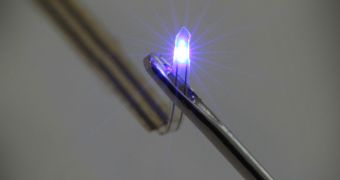Light emitting diodes are used for a lot of things nowadays, but soon they may be employed in implants, or injectable drugs / methods of treatment or internal nervous system stimulation. Researchers at the University of Illinois have designed LEDs that are so tiny that they can fit through the eye of a needle.
That means they can be injected into the bloodstream, or any other of the systems governing out bodies.
“Their dimensions are much smaller than those of an optical fiber, and they are much more mechanically compliant. Also, they are powered and controlled wirelessly, in a way that allows free motion of the animals, social interactions and other natural behaviors,” said John Rogers of the University of Illinois, a co-leader of the team that developed the lights.
The LEDs are flexible, making them comfortable and non-threatening, though the researchers make it a point of saying they aren't meant to be injected just anywhere into the body.
While it is definitely possible to fill a syringe with them and inject them into your arm, that will probably kill you.
Instead, the LEDs are being considered for brain implants, as neurons can be activated through bursts of light.
Wireless LEDs, for example, could allow for deep brain stimulation without needing to resort to invasive, dangerous, gruesome electrodes.
So far, the scientists have succeeded in inserting tiny LEDs in lab rat brains. The effects turned out to be some sort of light-based drug.
Nevertheless, even with the ease of implementation, there is still no chance of surgical or enhancement procedure being developed any time soon. And even if there are, the dangers and ethics of turning humankind into semi-bionic life forms are bound to cause much debate.
We will, of course, be sure to keep a close watch on the fireworks when those arguments start.

 14 DAY TRIAL //
14 DAY TRIAL //